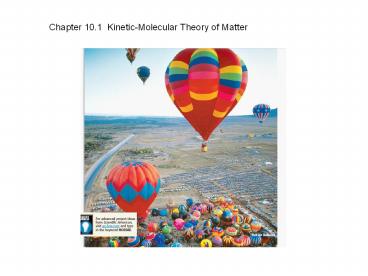Chapter 10.1 Kinetic-Molecular Theory of Matter - PowerPoint PPT Presentation
1 / 9
Title:
Chapter 10.1 Kinetic-Molecular Theory of Matter
Description:
Chapter 10.1 Kinetic-Molecular Theory of Matter An ideal gas is an imaginary gas that perfectly fits all the assumptions of the kinetic-molecular theory. – PowerPoint PPT presentation
Number of Views:346
Avg rating:3.0/5.0
Title: Chapter 10.1 Kinetic-Molecular Theory of Matter
1
Chapter 10.1 Kinetic-Molecular Theory of Matter
2
An ideal gas is an imaginary gas that perfectly
fits all the assumptions of the kinetic-molecular
theory.
3
Kinetic-Molecular Theory particles of matter are
always in motion (if not at absolute zero). 1.
Gases consist of molecules or atoms that are far
apart relative to their size. 2. Collisions
between gas particles and between particles and
container are elastic collisions. Elastic
collisions have no net loss of energy.
4
3. Gas particles possess kinetic energy. 4.
There are no forces of attraction or repulsion
between gas particles. 5. The average kinetic
energy of the gas particles depends on the
temperature of the gas. All gases at the same
temperature have the same average kinetic energy.
5
Expansion Fluidity Low Density Compressibility
Diffusion and Effusion
6
(No Transcript)
7
Real Gases occupy space and exert attractive
forces on each other. Under what conditions is a
gas more likely to behave as a real gas rather
than an ideal gas?
8
Which of the following gases would you expect to
deviate significantly from ideal behavior He,
O2, H2, H2O, N2, HCl, or NH3?
9
How does the kinetic-molecular theory explain the
pressure exerted by gases?































